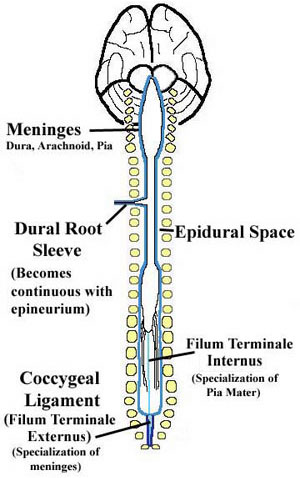 |
In summary, the spinal cord acts principally as a highway for information to travel between the brain and the periphery. The spinal cord begins at the foramen magnum and ends at L1/L2 as the conus medullaris. Caudal to the conus medullaris is the cauda equina, which consists of spinal nerve roots from the more caudal segments of the spinal cord. The spinal cord and most of the cauda equina is enclosed by the dural sac which ends at S2 and is connected to the coccyx by the coccygeal ligament. The 31 spinal nerves, which exit the spinal cord through the intervertebral foramina, are responsible for communicating between the spinal cord and the rest of the body. Dorsal rootlets from the dorsal horns and ventral rootlets from the ventral horns converge to form dorsal and ventral roots. The dorsal roots carry only sensory information and the ventral roots carry only motor information. Inside the intervertebral foramina are the dorsal root ganglia, the cell bodies for the peripheral sensory nerve fibers, which are pseudounipolar neurons. Distal to the dorsal root ganglia, the dorsal and ventral roots unite to form spinal nerves which are mixed nerves. The spinal cord gives rise to 31 spinal nerves, named for the vertebral segment where they exit the vertebral column. Spinal nerves are very short, branching shortly after exiting the intervertebral foramina into dorsal and ventral primary rami. The primary rami subsequently branch to supply the body. |







